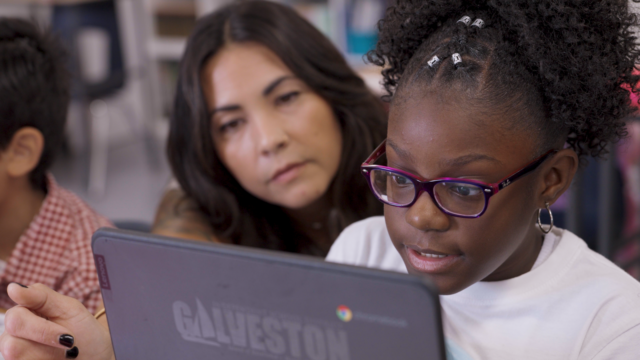
One of the reasons teachers and leaders give as part of why they love working in education is that no two days are the same. There is constant change and opportunity to innovate.
While that has always been true, the rate and type of change we have experienced in education since the pandemic has been more dramatic than ever. Before 2020, if a school had to shift to provide instruction in new ways, many schools had a computer lab or a cart of devices to share, rather than one-to-one devices for students. Many students did not have internet access outside of school, limiting their ability to do online research or use digital tools to school hours.
Fast forward to 2024, and it would likely be hard to find a district or school that has not significantly expanded access for all students. The increased availability of devices and the internet have introduced exciting possibilities for teaching and learning. Students across grade levels have had more exposure to digital content and online experiences than ever before. Educators have learned many ways to leverage the power of technology as a tool for teaching, and now it seems the next level of learning has arrived at the schoolhouse door: artificial intelligence, or AI.
Students with disabilities may have already had access to digital tools that supported them especially, but AI opened up new opportunities for learning about and using them. Consider the case of nonverbal students, for example. AI introduces new ways to communicate. More generally, students are able to participate and create in ways that may have not formerly even existed.
AI in education
In many ways, artificial intelligence, or AI, is being discussed as something new for educators to consider. The articles, presentations, books, podcasts, and, yes, blogs are plentiful and focus on different aspects of AI as part of the education landscape.
Yet when we spend time reading and considering the available information, it becomes apparent that AI has been working behind the scenes for many years and is growing in utility and sophistication. As early as 1964, a school district in New York introduced a “sophisticated teaching machine with an electronic computer at its heart” to teach young children to develop early literacy skills. Many iterations across professional fields and industries have since incorporated AI into their systems and products. The advent of ChatGPT in the fall of 2022 brought AI to a level of public awareness that suggested to many that AI was newly developed and introduced. Even though AI had been around for decades, the advent of ChatGPT suddenly had teachers and students reckoning with how to use AI in the classroom. A key factor in bringing AI into the classroom is supporting teachers so that they are successful. Secretary of Education Miguel Cardona has this to say: “If we’re serious about seeing AI transform education, we need to make sure that we’re providing time to give our educators the opportunity to learn and grow with it.”
Using AI in special education
Just because AI is available, that doesn’t mean it’s simple to slot into a classroom. To use AI for special education needs, where do you start? Dr. Ovett Chapman from Pendergast Elementary School District 92 in Arizona suggests a three-stage approach to leveraging AI in special education:
- Stage 1: Explorer
- Stage 2: Champion
- Stage 3: Innovator
These stages can be applied to all team members in special education and allow everyone to have an important role.
Stage 1: Explorer
Exploring means that teachers interact with AI platforms and resources and learn how AI is used for planning, delivering instruction, and developing personalized learning experiences. The first step for many educators is to explore AI tools that support their productivity. What are particular tasks that AI can accomplish to save them time? This exploration is crucial for understanding and effectively using AI features.
Special education teachers might begin by exploring the research in the field of AI. There are abundant sources for teachers to explore ways to use AI to develop IEP supports, design individual lessons, manage assessments, and monitor progress. What is the research telling us about the effective use of AI for special education service delivery? Where do we have exemplars to learn from, and how can we replicate their success?
AI for special education teachers or leaders might also support data collection, goal development, and communication about student progress. Many districts and schools have already adopted curricular resources with AI features that save teachers time and support individualized instruction. District and school leaders can encourage exploring these resources and provide time for teachers to learn how to use the tools.
If we’re serious about seeing AI transform education, we need to make sure that we're providing time to give our educators the opportunity to learn and grow with it.
U.S. Secretary of Education
Stage 2: Champion
Becoming a champion will require educators to actively use AI tools beyond the exploration phase. A champion doesn’t have to be the most expert user. Instead, a champion is a leader or teacher who has learned more about AI and is ready to support others in leveraging AI for teaching and learning. When one educator is willing to share successes, challenges, and all the joys and perils of the journey and provide both examples and experiences, others will be inspired to explore AI.
A champion vets resources in the exploration phase, ensuring meaningful recommendations. It is important to understand the purpose of each tool. AI is embedded in many school resources for specific purposes, and maximizing its power requires leaders and teachers to understand the resources’ design and intent. In tools that include generative AI to produce content, users need to learn how to create specific, intentional prompts and develop a process for critical review of AI-generated resources.
Stage 3: Innovator
Innovating with AI in special education opens new pathways for teachers and students across content areas. Innovating can also mean generating content that was otherwise too time-consuming or complex to include in instruction. Innovation will never mean replacing the teacher. In this case, innovation means using AI as a valuable tool that can expand or enhance teaching and learning in new ways.
Imagine how AI can simplify complex tasks for teachers such as creating groups, adapting materials, personalizing learning, and communicating student performance. AI also supports students by scaffolding tasks and providing supports for expanded vocabulary and creative expression, opening new possibilities for learning and demonstrating understanding and mastery. Innovation with AI can follow a best practice of Universal Design for Learning: providing options, a key characteristic for including the needs of all learners.
Innovation is especially welcomed by leaders and teams who provide specially designed instruction for students with disabilities. We know that nearly two-thirds of students with disabilities spend at least 80% of their time in a general education setting. To maintain and expand this inclusive approach, both special and general education teams can innovate on co-teaching, progress monitoring, and personalizing instruction through AI. The amount and type of collaboration between educators is almost unlimited when the entire team has access to tools that can adapt content to students and support them in generating work products, expressing themselves creatively, demonstrating mastery of skills, and collaborating with peers.
AI tools for special education teachers
It can feel daunting to figure out how to get started. It is amazing how many great tools are out there, and it’s hard to choose a few. But here are some AI tools for special education that teachers can take advantage of:
- Writable: This is a tool for Grades 3–12 from HMH that uses teacher-guided generative AI to teach and assess writing. Here, AI is used to save teachers time and provide students with timely, specific, and personalized feedback. Writable is unique because it not only uses AI as part of the instructional platform but also includes AI detection. Teachers everywhere have expressed concern about students using AI to complete writing assignments, which Writable addresses through both its internal AI detection and the AI-powered Turnitin that assesses originality in student work.
- MindMeister: This is a publicly available AI tool with a free “Basic” plan that special education teachers can use to support students in brainstorming, organizing their ideas, and making connections. Sometimes it can be challenging for students with learning disabilities to organize their thoughts and ideas in a connected way. MindMeister provides students with a visual organizer that helps them to connect and study content or to generate new ideas.
- Calendar.AI: This is a general AI tool that can be used for a variety of tasks like scheduling your calendar and managing contact information for upcoming meetings. The app provides more than dates and times; it can share insights on the people or companies with appointments on your calendar and has a scheduling assistant component. Another time saver!
The future of AI
AI offers great potential to bring new ideas and strategies to our districts, schools, and classrooms. Educators are often among the most highly creative and passionate professionals. Their work relies on energy and enthusiasm for new approaches and tools to advance student learning. The combination of AI’s power and our educators’ talents paint an education landscape with exciting advancements on the horizon.
In the video below, I speak with a panel of administrators and experts in specially designed instruction on the power and potential of AI in special education. This is part of a longer webinar “Today’s MTSS Classroom: Meeting the Instructional Needs of ALL Students.”
In April 2024, Dr. Suzanne Jimenez spoke to a panel of educators and education experts about using AI to meet the instructional needs of all students.
We know that planning and caution are essential for any system changes. Many districts are beginning to develop guidelines or policies for staff and students when using AI. Only a few states have started to draft regulations or policies, often called guidance. So much is unknown about how AI will impact our learning systems. One thing is for sure: AI is here to stay. Its impact is likely to grow too, and it is vital for educators to learn and lead so that our students will develop skillful, ethical, and high-achieving practices.
***
Streamline feedback and grow great writers with Writable. Scaffold student practice, increase engagement, and connect writing to your daily instruction, all while leveraging AI. Request a free demo here.
Discover best practices for integrating AI in the classroom.














